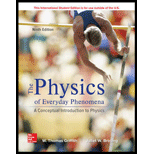
Suppose an astronaut travels to a distant star and returns to Earth. Except for brief intervals of time when he is accelerating or decelerating, his spaceship travels at the incredible speed of v = 0.995c relative to the Earth. The star is 46 light-years away. (A light-year is the distance light travels in 1 year.) a. Show that the factor γ for this velocity is approximately equal to 10.
a. How long does the trip to the star and back take as seen by an observer on Earth?
b. How long does the trip take as measured by the astronaut?
c. What is the distance traveled as measured by the astronaut?
d. If the astronaut left a twin brother at home on Earth while he made this trip, how much younger is the astronaut than his twin when he returns?
(a)
To show that the factor
Answer to Problem 3SP
It is shown that the factor
Explanation of Solution
Given info: The velocity of the spaceship is
Write the expression to find the
Here,
Substitute
Conclusion:
Therefore, it is shown that the factor
(b)
The time taken for the travel to the star and back to earth as seen by an observer on earth.
Answer to Problem 3SP
The time taken for the travel to the star and back to earth as seen by an observer on earth is
Explanation of Solution
Write the expression to find the distance travelled in meter.
Write the expression to find the time taken by the spaceship to travel back and forth.
Here,
Substitute
Conclusion:
Therefore, the time taken for the travel to the star and back to earth as seen by an observer on earth is
(c)
The time taken for the travel to the star and back to earth as seen by the astronaut.
Answer to Problem 3SP
The time taken for the travel to the star and back to earth as seen by the astronaut is
Explanation of Solution
Write the expression to find the distance travelled in meter.
Write the expression to find the time taken by the spaceship to travel back and forth as seen by the astronaut.
Here,
Substitute
Conclusion:
Therefore, the time taken for the travel to the star and back to earth as seen by the astronaut is
(d)
The distance travelled as measured by the astronaut.
Answer to Problem 3SP
The distance travelled as measured by the astronaut is
Explanation of Solution
Write the expression to find the distance as measured by the astronaut.
Here,
Substitute
Conclusion:
Therefore, the distance travelled as measured by the astronaut is
(e)
The age difference between the astronaut and his twin after he returns from his space journey.
Answer to Problem 3SP
The age difference between the astronaut and his twin after he returns from his space journey is
Explanation of Solution
Write the expression to find the age difference between the astronaut and his twin.
Here,
Substitute
Conclusion:
Therefore, the age difference between the astronaut and his twin after he returns from his space journey is
Want to see more full solutions like this?
Chapter 20 Solutions
Physics of Everyday Phenomena
- 20. Two small conducting spheres are placed on top of insulating pads. The 3.7 × 10-10 C sphere is fixed whie the 3.0 × 107 C sphere, initially at rest, is free to move. The mass of each sphere is 0.09 kg. If the spheres are initially 0.10 m apart, how fast will the sphere be moving when they are 1.5 m apart?arrow_forwardpls help on allarrow_forwardpls help on thesearrow_forward
- pls help on all asked questions kindlyarrow_forwardpls help on all asked questions kindlyarrow_forward19. Mount Everest, Earth's highest mountain above sea level, has a peak of 8849 m above sea level. Assume that sea level defines the height of Earth's surface. (re = 6.38 × 106 m, ME = 5.98 × 1024 kg, G = 6.67 × 10 -11 Nm²/kg²) a. Calculate the strength of Earth's gravitational field at a point at the peak of Mount Everest. b. What is the ratio of the strength of Earth's gravitational field at a point 644416m below the surface of the Earth to a point at the top of Mount Everest? C. A tourist watching the sunrise on top of Mount Everest observes a satellite orbiting Earth at an altitude 3580 km above his position. Determine the speed of the satellite.arrow_forward
- pls help on allarrow_forwardpls help on allarrow_forward6. As the distance between two charges decreases, the magnitude of the electric potential energy of the two-charge system: a) Always increases b) Always decreases c) Increases if the charges have the same sign, decreases if they have the opposite signs d) Increases if the charges have the opposite sign, decreases if they have the same sign 7. To analyze the motion of an elastic collision between two charged particles we use conservation of & a) Energy, Velocity b) Momentum, Force c) Mass, Momentum d) Energy, Momentum e) Kinetic Energy, Potential Energyarrow_forward
 University Physics Volume 3PhysicsISBN:9781938168185Author:William Moebs, Jeff SannyPublisher:OpenStax
University Physics Volume 3PhysicsISBN:9781938168185Author:William Moebs, Jeff SannyPublisher:OpenStax Principles of Physics: A Calculus-Based TextPhysicsISBN:9781133104261Author:Raymond A. Serway, John W. JewettPublisher:Cengage Learning
Principles of Physics: A Calculus-Based TextPhysicsISBN:9781133104261Author:Raymond A. Serway, John W. JewettPublisher:Cengage Learning Physics for Scientists and Engineers with Modern ...PhysicsISBN:9781337553292Author:Raymond A. Serway, John W. JewettPublisher:Cengage Learning
Physics for Scientists and Engineers with Modern ...PhysicsISBN:9781337553292Author:Raymond A. Serway, John W. JewettPublisher:Cengage Learning Physics for Scientists and EngineersPhysicsISBN:9781337553278Author:Raymond A. Serway, John W. JewettPublisher:Cengage Learning
Physics for Scientists and EngineersPhysicsISBN:9781337553278Author:Raymond A. Serway, John W. JewettPublisher:Cengage Learning College PhysicsPhysicsISBN:9781305952300Author:Raymond A. Serway, Chris VuillePublisher:Cengage Learning
College PhysicsPhysicsISBN:9781305952300Author:Raymond A. Serway, Chris VuillePublisher:Cengage Learning College PhysicsPhysicsISBN:9781285737027Author:Raymond A. Serway, Chris VuillePublisher:Cengage Learning
College PhysicsPhysicsISBN:9781285737027Author:Raymond A. Serway, Chris VuillePublisher:Cengage Learning





